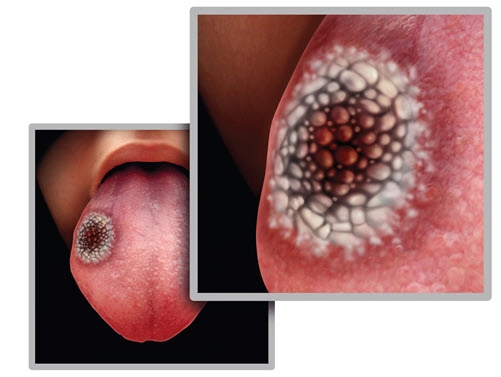Pick Up CISH Pay in Tongue Biopsy Case
See if dx could impact exam code selection. When you’re reporting a pathology tissue exam case, you sometimes find that the procedure, ancillary service, and diagnosis coding are inextricably linked. Check out this tongue specimen case to see how a special stain leads to a diagnosis that leads back to the correct procedure code. Try Your Hand at This Case The surgeon submits a biopsy of a white lesion from the back of the patient’s tongue. Gross: Pathologist describes 0.9 cm tongue tissue specimen with folded appearance and slightly ulcerated surface, processed as a single block. Microscopic: Findings include hyperkeratotic mucosa, papillary acanthosis appearing as koilocyte-like cells, intranuclear inclusions with a halo, and absence of Langerhans cells. A chromogenic in situ hybridization (CISH) of RNA probes demonstrate the presence of Epstein Barr virus-encoded RNA (EBER) in epithelial cells. Diagnosis: The pathologist diagnoses the tongue specimen as hairy leukoplakia. Check The Dx You Would Assign “You should always assign the diagnosis code from the pathology report when the final diagnosis is available at the time of billing,” says Terri Brame Joy, MBA, CPC, COC, CGSC, CPC-I, revenue cycle director for Clinical Health Network for Transformation in Houston, Texas. In this case, the correct diagnosis code is K13.3 (Hairy leukoplakia). This code “is a direct link when using the ICD-10-CM Index and is verified in the Tabular List” of the ICD-10-CM code book, says Kelly C. Loya, CPC-I, CHC, CPhT, CRMA, associate partner, Pinnacle Enterprise Risk Consulting Services LLC, in Centennial, Colorado. The differential diagnosis of oral hairy leukoplakia can be problematic in some cases, because lesions may present as one of the following: Key: CISH test findings of the presence of EBV in epithelial cells distinguish the lesion as hairy leukoplakia. The absence of Langerhans cells, which are immune cells that present to viral and other antigens, may permit replication of EBV and serve as another marker for oral hairy leukoplakia. See If Your Pathology Exam Code Is Correct The appropriate pathology exam procedure code for this case is 88305 (Level IV - Surgical pathology, gross and microscopic examination … Tongue, biopsy …). The surgeon identified the specimen as a biopsy, so the procedure code is clear. Caveat: CPT® provides a different code for tongue specimens that you should be familiar with: 88309 (Level VI - Surgical pathology, gross and microscopic examination … Tongue/tonsil -resection for tumor). Tongue is not a listed specimen under 88307 (Level V - Surgical pathology, gross and microscopic examination…), so 88307 is not an option for tongue cases. That’s because you must base your surgical pathology code selection on the specimens listed under each code 88300-88309. You are allowed to assign a code based on the level of work only if the specimen is not listed. If the surgeon had identified the specimen as a lesion excision “suspicious for cancer,” the 88309 code may be more appropriate. The choice between 88305 versus 88309 is whether the specimen is a biopsy or a resection, and whether the exam is “for tumor.” Key: A biopsy is a piece of tissue removed only for diagnostic purposes, not as a treatment to remove all diseased tissue. The surgeon should describe the specimen as a biopsy, and you would expect a surgical code such as 41105 (Biopsy of tongue; posterior one-third). On the other hand, a resection such as 41120 (Glossectomy; less than one-half tongue) involves surgical treatment to remove all affected tissue, almost always for cancer. Lesion excision: If the surgeon submits a specimen called a tongue “lesion excision” from a surgical procedure such as 41110 (Excision of lesion of tongue without closure), is that an 88305 or 88309 specimen? The answer depends on whether the surgeon indicates that the lesion is suspicious for cancer. “If the pathologist examines an excised tongue lesion for cancer, you should code the 88309 service,” says R.M. Stainton Jr., MD, president of Doctors’ Anatomic Pathology Services in Jonesboro, Arkansas. That’s true regardless of the specimen size or whether the final diagnosis confirms cancer. Did You Catch the Special Stain? The pathologist documented performing a CISH test for Epstein Barr virus (EBV). When the technique results in hybridization to EBER transcripts in cell nuclei, that indicates a latent EBV infection. The positive test findings were crucial to determining the differential diagnosis of hairy leukoplakia. You should code the CISH test as 88365 (In situ hybridization (eg, FISH), per specimen; initial single probe stain procedure). Note: The use of “FISH” in the code descriptor is an example of in situ hybridization methodology. The code descriptor does not exclude other ISH techniques such as chromogenic ISH.





